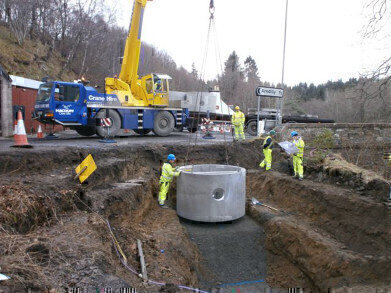Water/Wastewater
Raising a Toast to SuDS on a Steep Scottish Mountain Highway
Oct 15 2012
Highway degradation and surface water pollution in an environmentally sensitive area of the Scottish Cairngorms Mountains famous for its whisky production have been tackled with an imaginative SuDS Solution from Hydro International (UK) which has averted potential road safety problems on the A95.
Poor drainage, flooding and freezing weather had led to a landslip and extreme surface degradation along a section of the narrow A95 that descends on a 10% gradient with tight bends to the picturesque village of Craigellachie on the River Spey, near Elgin.
Located immediately above the River Fiddich, a tributary of the River Spey and a Special Area of Conservation, the area is also world-renowned for the production of single malt whisky and is an important salmon fishery. Control of any surface water runoff would therefore have to include measures which maintained the clarity and purity of the water.
By working with Hydro International’s stormwater design team, BEAR Scotland specified a long term surface water drainage solution which delivered control of surface water flows and minimised any potential pollution from hydrocarbons into the watercourses below. The solution incorporated three Hydro-Brake Flow Controls within pre-cast concrete weir wall chambers and a Downstream Defender hydrodynamic vortex separator.
Investigations as part of Transport Scotland’s upgrade of this section of the A95 Aviemore to Keith Trunk Road, revealed that surface water flowing down the steep hillside had been infiltrating the road foundation structure along the 0.9km stretch near Craigellachie. The water flow had been washing away the aggregate layers and causing a loss of load bearing capacity, leading to premature wear, edge deterioration, and in one location a landslide that resulted in a retaining wall being constructed.
Under the Water Environment (Controlled Activities)(Scotland) Regulations 2011, the drainage from major roads must be subject to control of any diffuse pollution to help meet the objectives of the EU Water Framework Directive. There were also concerns on the potential of the reconstruction work affecting the water environment, so care was needed to prevent any accidental pollution.
Other restrictions, under the General Binding Rule 10 of The Scottish Environment Protection Agency (SEPA), stipulate that any road construction must be drained by a SuDS scheme to ensure flow and pollution control. SEPA Pollution Prevention Guidelines 5 and 8 carefully regulate works which could affect water and look for at least two forms of treatment to the surface water runoff.
An existing short retaining wall and a series of ditches were proving inadequate, especially as rainfall intensity is increasing with climate change. Simply improving the ditch volume and water retention with a conventional approach such as cast concrete channels was not an option due to space within the highway boundary. Also, the lack of flow control would risk additional sediment being washed into the river.
The basis of the scheme, undertaken by contractor, the Coffey Group, was to excavate and deepen the existing ditches. These were lined with heavy duty polyethylene to prevent seepage into the road structure then filled with carefully graded filter drain aggregate. Flow through the new channels is limited by a series of check dams before eventually discharging into a new pipeline constructed under the road.
The water flow in the pipeline is controlled by a series of three Hydro-Brake® Flow Control devices, located at 300 metre intervals in weir wall concrete chambers under the road. The controlled discharge of the maximum design flow of the Hydro-Brake® units also enables the pipeline to be used as a temporary storage chamber to help mitigate storm events.
The last of the three Hydro-Brake units is located at the downslope end of the pipeline, in front of the Hydro Downstream Defender. This device ensures high sediment retention even during storm events, with no re-entrainment, while controlling floatables and providing hydrocarbon separation. The Downstream Defender discharges over a reinforced rip rap face set into the embankment to control erosion, and then to the river.
Events
Jul 15 2025 Brighton, UK
Jul 23 2025 Sydney, Australia
Aug 24 2025 Stockholm, Sweden and online
Aug 27 2025 Busan, South Korea
Sep 02 2025 Mexico City, Mexico














